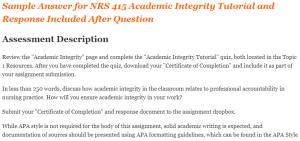Sample Answer for NRS 415 Academic Integrity Tutorial and Response Included After Question
Assessment Description
Review the “Academic Integrity” page and complete the “Academic Integrity Tutorial” quiz, both located in the Topic 1 Resources. After you have completed the quiz, download your “Certificate of Completion” and include it as part of your assignment submission.
In less than 250 words, discuss how academic integrity in the classroom relates to professional accountability in nursing practice. How will you ensure academic integrity in your work?
Submit your “Certificate of Completion” and response document to the assignment dropbox.
While APA style is not required for the body of this assignment, solid academic writing is expected, and documentation of sources should be presented using APA formatting guidelines, which can be found in the APA Style Guide, located in the Student Success Center.
You are not required to submit this assignment to LopesWrite.
American Association of Colleges of Nursing Core Competency for Professional Nursing Education
This assignment aligns to AACN Core Competency 10.1.
A Sample Answer For the Assignment: NRS 415 Academic Integrity Tutorial and Response
Title: NRS 415 Academic Integrity Tutorial and Response
Integrity, either in academic or professional nursing practice, is a core aspect of delivering quality nursing care. Good academic work entails practicing honesty, trust, and respect that nursing students should nurture and adhere to as they transition to offer patient care in different settings and when dealing with diverse patients. Academic integrity relates to professional integrity as an honest nurse and healthcare provider ensures that they provide required patient care (Lynch et al., 2022). Academic integrity implores nurses to uphold professional and ethical values and standards in their learning activities that will translate to accountability in their practice settings. Professional accountability entails the responsibility of nurses to offer safe, ethical, quality, and optimal patient care (Harris et al., 2020). Professional accountability has a direct link with academic integrity as nurses apply the knowledge and skills attained in academic activities in work settings (Miron et al., 2022). The American Nurses Association (ANA) asserts that nurses are responsible for their actions, decisions, and care offered to patients (Pittman et al., 2020). As such, they must uphold integrity as a core part of attaining their professional accountability requirements.
I intend to ensure academic integrity in my work by practicing the ethical values of honesty, fairness, respect, and trust. I will ensure that I do not engage in any activities that can negatively affect my academic work and take responsibility for my learning through active participation in assigned activities. Upholding academic integrity will prepare me for future roles in different care settings and caring for patients.

References
Lynch, J., Glew, P., Salamonson, Y., & Ramjan, L. M. (2022). “Integrity is integrity. It doesn’t
matter the context”: A qualitative exploratory study of academic integrity in an undergraduate nursing program. Teaching and Learning in Nursing, 17(4), 465-470. https://doi.org/10.1016/j.teln.2022.06.013
Harris, L., Harrison, D., McNally, D., & Ford, C. (2020). Academic integrity in an online
culture: do McCabe’s findings hold true for online, adult learners? Journal of Academic Ethics, 18, 419-434. DOI:10.1007/s10805-019-09335-3
Miron, J., Wilson, R., Freeman, J., & Sears, K. (2022). Academic Integrity in upper Upper-year
Nursing students’ work-integrated settings. International Journal for Educational Integrity, 18(1), 1-19. DOI: https://doi.org/10.1007/s40979-022-00107-y
Pittman, O. A., & Barker, E. (2020). Academic dishonesty: What impact does it have and what
can faculty do? Journal of the American Association of Nurse Practitioners, 32(9), 598-601. DOI: 10.1097/JXX.0000000000000477.

